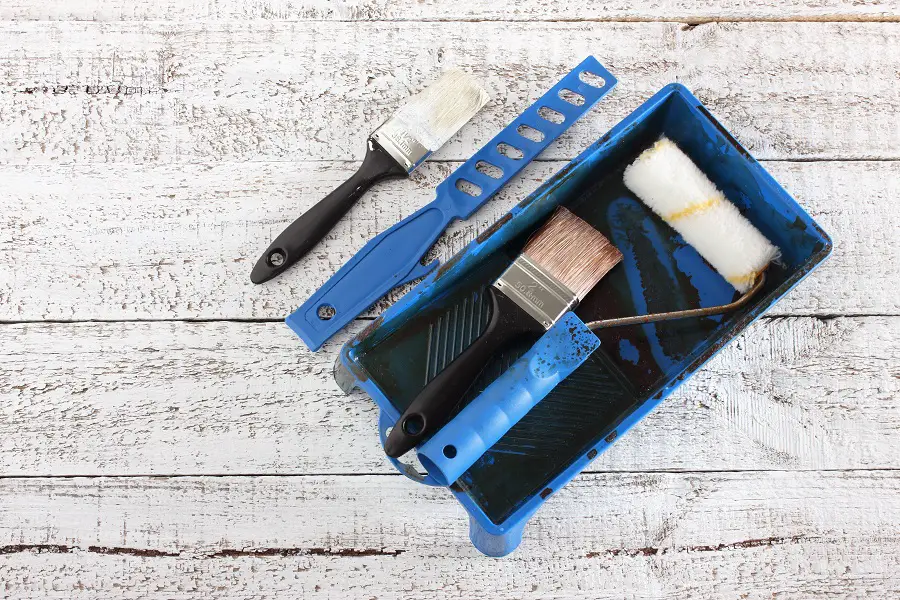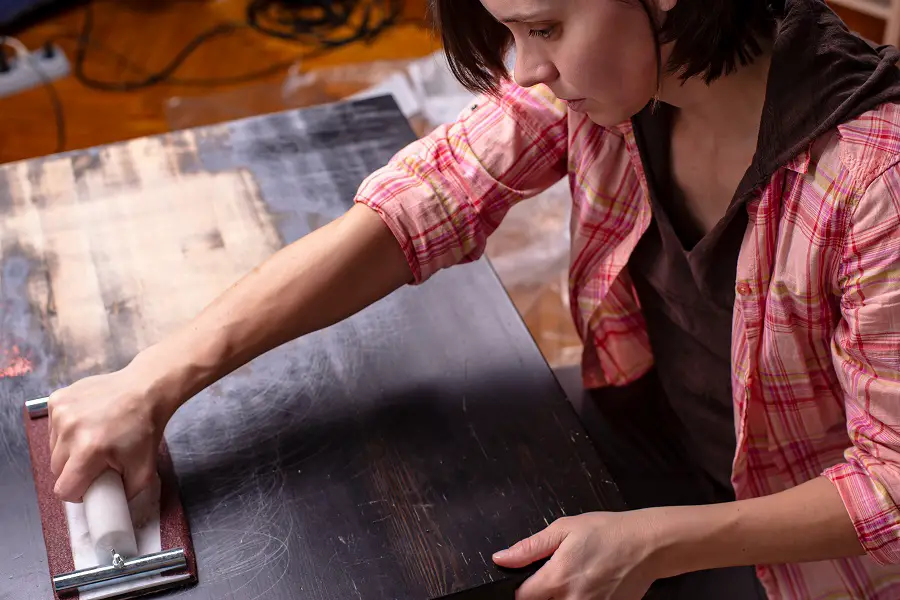There are days when we have to stay indoors and we need activities to make the time pass more quickly and easily. Do-it-yourselfers can make the quarantine more bearable by transforming old furniture, freshening up the paint on doors or windows, painting frames or other wooden objects. And those with carpentry workshops can learn more about finishing.

I wrote here and here about problems that can occur when finishing surfaces with wax or oil. I thought that an article grouping the problems that can occur when applying paint or varnish and how they can be solved might be helpful. Especially as many of the questions I receive from you are related to this topic.
Preparing surfaces before repainting
But first, a few tips on how to prepare objects before repainting. Over time, an old object collects dust and grease, which settle on the surface. If you want the surface to look good in the end and the paint not to peel off at the slightest touch, you should clean the objects before applying the new coat of paint.
Don't panic, it's nothing complicated. Cleaning is done with water and soap scum or dishwashing detergent. I recommend these products because they are very effective at removing grease. Make a not very concentrated solution and using a soft cloth (old cotton t-shirts are best) wash the surfaces. CAUTION: the water must not boil. Wring out the cloth before wiping objects. Excess water can penetrate deeply and loosen parts of furniture or upholstery.
Once you have wiped all the surfaces thoroughly, paying particular attention to where the dirt is hardest to remove, wipe everything with clean water, again with a soft cloth wrung out well. Finally, wipe again with a dry cloth and leave to soak for a few hours before applying the new coat of paint or varnish.
Degreasing is mandatory for furniture. Commercially available furniture care products contain some wax. This remains on the surface and not only binds dust, but also greatly weakens the adhesion of the new coat of paint.
And no, water doesn't whiten the furniture unless it's in excess and puddles (sits for a long time) on the surface.

Some of the problems that can occur when varnishing or painting and how to solve them
Back to the problems that can occur when painting or varnishing. I've limited myself to those that occur when paints are applied with a brush, trafalet (roller) or simple spray gun (can gun).
1. Rough surface
There may be several causes:
- the film has trapped dust or other impurities in the atmosphere,
- the film has buried air,
- if the application has been made directly on the wood, it has not been properly sanded beforehand
Dust is the enemy of varnish or paint films, especially when they are glossy. To avoid trapping dust in the wet film, avoid working outdoors in open spaces and use varnishes and paints that dry more quickly. But not too fast (do not force drying with heat sources such as hot air blowers) because then the air in the film will not have time to escape and you will end up with the same result. There is always air in the film, regardless of the method of application, but the least you get is if you use a stiff sponge mop.
If you apply the paint directly to the wood, it must first be sanded with 180-220 grit sandpaper or medium abrasive sponges and then wiped off with a damp cloth. Do not apply paint immediately unless it is water-based. Read more about sanding wood (white sanding) here.
To get a smooth, pleasant to the touch surface you will need to sand the rough surface very well with a fine abrasive sponge or 280-320 grit sandpaper (or 400 grit if the varnish or paint is very glossy) until the roughness is removed (it feels very rough to the hand), dust very well with a cloth, allow any dust in the atmosphere to settle and carefully apply another coat of varnish or paint. Apply thin coats as a thicker film is less elastic and may crack.
If the object you are finishing is glossy, you can remove the roughness from the film by polishing. Find out how to polish here. This method is not recommended for matt lacquers as it will increase the gloss.
If you have a special space where you're painting, you can sprinkle water on the floor (as you do in summer before sweeping). Water attracts dust and holds it.
2. Orange peel appearance
After drying, the film is not perfectly smooth, looking very much like orange peel. It is visible immediately after applying the varnish (the glossier it is, the more visible it is), but may disappear after drying. Lacquers and paints are viscous and need time to set. If this time is less than the drying time, the final film will not be smooth. The viscosity is regulated by solvents (water or organic solvents). If the varnish or paint is thick, it must be thinned to make it set as well as possible.
Orange peel can also occur if the varnish and the object are brought from an unheated warehouse and have not been allowed to reach a temperature above 15°C. If the application is made with a spray gun, the distance between the gun and the object as well as the air pressure may cause the defect to appear. The distance should be min. 25 cm and the pressure 3-4 atm. Those of you who have a compressor for staple guns in your workshop, do not use the same pressure when applying lacquers. In addition to the orange peel looking film you will also have high loss of lacquer.
Sanding and repainting also solves this problem. The sanding should be done more deeply, not just superficially, to remove any unevenness in the film. After sanding, apply a thin and appropriately thinned coat of lacquer and do not force dry.
3. Film punctures
The defect may look like air bubbles left in the film, but it's different. If you look closely you'll see fine needle-like pinpricks clustered together. They appear when varnishes or paints are sprayed on.
There are two causes of the defect:
- water accumulated in the compressor which, for various reasons, ends up in the gun,
- spraying water-based and solvent-based products is done with the same gun.
In the first case, stings occur if the varnish is solvent-based. Moisture in the atmosphere accumulates in the compressor or on the hoses and ends up in the gun where it is transformed into very small droplets and mixed with the varnish. As water and solvent don't understand each other, the fine water droplets reach the surface and form those tiny pinhole-like holes. The problem is solved by putting filters on the trails, checking and draining the compressor more often, especially during periods of high humidity.
In the second case, the stings also occur because the water and the solvent don't understand each other. If solvent-based varnish is sprayed after water-based varnish and the gun has not been washed very well, these stings occur. It is recommended to rinse the gun with acetone after washing. Acetone is compatible with both water and solvent.
Removing the pits is also done by sanding vigorously and applying a new coat of varnish or paint.
4. Craters (fish eyes) in the film
You can see it immediately after applying the varnish/paint or immediately after. Looks like when water gets on a greasy surface. The culprits are traces of grease, oil or wax on the surface because it has not been washed and degreased properly or silicone particles in the atmosphere . The greasy substances can be on your hands or on the cloths you use to wipe surfaces. Silicone particles get onto the surface from the air, where they can linger for days after being used to insulate or fix windows (even a long distance from where the finishing is being done).
Unfortunately, in this case, the entire layer must be sanded off, the surface thoroughly degreased and the finish refinished. When it comes to silicone, there are special thinners that can be used in conjunction with solvent-based varnishes to counteract its effects.
5. Shadows (white clouds) in the film
Occurs when drying has been too rapid and the solvent has not had time to fully exit the film. It is more visible with water-based products, but can also occur with solvent-based products. The humidity in the atmosphere is also very important. When it is high, the chances of film bleaching are greater. For water-based products, air circulation during drying is also important. If the temperature is high and there are no air currents, the film dries on the surface (closes) before all the water has drained out.
If there is not a large amount of solvent inside, the problem can be solved by slightly heating the film. This method is valid for both water-based and solvent-based products without hardener (nitrocellulose varnishes).
With exterior water-based products, the defect can still appear a few days after finishing. For example, if water-based exterior varnish is applied to window frames and a rainy spell comes a few days later, the varnish may bleach even if the raindrops have not reached the finished surface. This is not serious, the film will return to its original appearance as the sun comes out. This is natural with water-based varnishes, which continue to exchange moisture with the environment for another 2-3 weeks after the varnish has been applied.
6. The film scratches very easily
When the film scratches very easily and the scratch is a broad whitish streak, it is not a varnish that scratches easily but poor adhesion to the old varnish layer. It happens when solvent-based varnish is applied over an old coat of water-based or gloss varnish. Because of the low adhesion, when mechanical action (knocking, scratching) occurs, the lacquer peels off and air gets underneath (hence the white color).
If you want to apply solvent-based varnish to an older, glossy surface, sand after degreasing. It is good to test the compatibility of the materials beforehand in a more hidden place. If they don't separate immediately or the solvent doesn't attack the undercoat (looks like it's blooming), they are compatible. Sand with fine abrasive sponges or 280 or 320 grit sandpaper. Lacquer is applied after sanding.

7. Cracks in the film
Cracks in the film can occur because of the varnish/paint and the way it is applied, or because of the natural movement of the wood as the humidity in the air rises or falls. In the first case the cracks are uneven all over the surface, in all directions, without following any particular pattern. In the second case, the cracks will be along the grain of the wood or along the joints.
When talking about cracks due to the varnish and the way it is applied, the causes can be too thick a layer, poor adhesion, brittle varnish due to too much hardener, application at too low a temperature, choosing the wrong varnish for the way the object is used, water-based varnish that has frozen. To rectify the problem, the entire varnish layer must be removed by sanding and refinished using a suitable varnish and following the application instructions.
Cracks due to wood movement are caused by wood with too high or too low moisture content, or by incorrect drying (too quickly, at too high a temperature, without checking the temperature inside the wood, not just the surface temperature), or by low elasticity of the varnish or adhesive. In this case too, the varnish layer must be removed, the wood humidity checked (which must be 8-12% also on the inside, not just on the surface) and a varnish with higher elasticity applied.
I hope you find these few explanations useful. More can be said about each of the defects, but I have chosen to present the main ideas. If you would like to know more or have encountered any other film defects that you would like to clarify, please write below in the space provided. I will certainly reply.
Stay optimistic! It will pass and it will be okay!




































Hello... I want to refurbish a ceiling of solid wood panelling painted with varnish (I also want to repaint it with varnish). The panelling is in the kitchen .... please tell me how to proceed!? Thank you!
Hello!
Depending on how damaged the old varnish layer is, you have 2 possibilities: total removal of the old varnish layer and repainting or applying a new layer of varnish over the old one. In the first case it is more difficult. You will have to remove the old varnish completely by sanding or pickling, sand the cleaned wood well and apply 2 coats of water-based or polyurethane varnish (with hardener). In the second case you will have to wash the old layer to degrease and clean it, wipe it well with a soft dry cloth and sand it lightly to give the new layer adhesion. Apply water-based varnish. This is compatible with most varnishes, but to get adhesion you need to sand the old coat off roughly.
More information in the links below.
All the best!
https://revistadinlemn.ro/2017/06/13/cum-sa-aduci-la-viata-cufarul-vechi-din-pod/
https://revistadinlemn.ro/2017/09/15/cum-se-curata-stratul-vechi-de-vopsea/
https://revistadinlemn.ro/2020/04/07/albirea-mobilei-din-cauza-dezifectantilor/
Good evening! For a ceiling made of resinous wood panelling, is it sufficient just to varnish it or should I apply a coat of linseed oil beforehand? Can you help me with a type of varnish? The ceiling is indoors, 80sqm, can it be varnished with a spray gun or would it be better with a brush? Thanks a lot!
Hello!
Just oil is enough. If you want to coat it you should only use alkyd varnish because nothing else will adhere to the oil.
But I consider the oil sufficient for a ceiling panelling. However, I recommend applying 2-3 coats of oil, with a 24-hour break between applications and wiping off the excess 30-60 minutes after application. This way the wood will absorb what is needed and will be very well protected.
All the best!
https://revistadinlemn.ro/2018/05/15/ulei-de-in-cand-unde-si-cum-se-foloseste-cum-sa-ti-faci-singur-vopsele-de-ulei/
https://revistadinlemn.ro/2019/04/17/7-reguli-de-respectat-la-finisarea-cu-ulei-a-lemnului/
Hello, I have a problem...my wife applied a light resin based varnish on the stairs, I think it's from kober...over the old varnish and it doesn't dry any more.I mean it stays sticky and leaves marks on the touch, but it doesn't get on the finger etc.
What's going on and how can I fix it? Thanks
Hello!
From what you say, I'm guessing it's the oil-based or alkyd varnish that's usually used for wood that's outside. Such products are not recommended for stairs because they are more elastic and softer. They are specifically made to not crack when the wood changes dimensionally with increasing or decreasing outdoor humidity. I think the coating was very thick, the solvent couldn't get out and the varnish didn't dry, it stayed tacky.
Unfortunately, the only solution is to remove everything down to the wood with a paint remover you can find in DIY stores like Dedeman. How to do the stripping is described at length in the link below. After removing the soaked sticky varnish with a squeegee, wipe the surface of the stairs with a cloth with paint thinner and let it dry. Then apply special floor varnish (water-based or solvent-based) which you can also find in such shops.
I've also put a link explaining why outdoor products are not used to protect floors and stairs.
All the best!
https://revistadinlemn.ro/2022/09/08/cum-sa-cureti-cu-decapant-straturile-vechi-de-vopsea/
https://revistadinlemn.ro/2023/06/21/de-ce-nu-se-foloseste-lac-de-exterior-pentru-protectia-parchetului-si-scarilor-interioare-din-lemn/